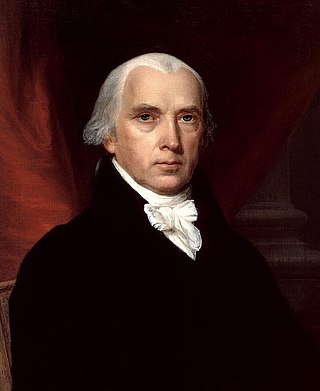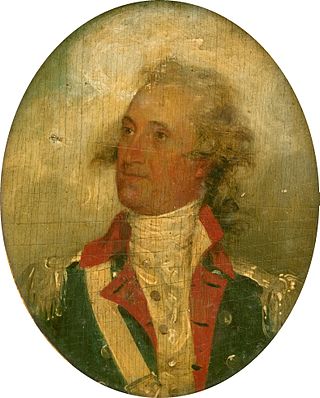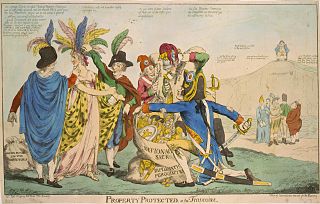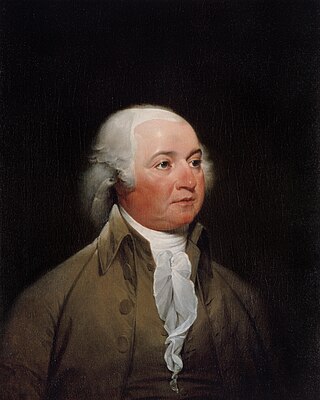Related Research Articles

Elbridge Gerry was an American Founding Father, merchant, politician, and diplomat who served as the fifth vice president of the United States under President James Madison from 1813 until his death in 1814. He is known to be the father of the political practice of gerrymandering.

The Federalist Party was a conservative and nationalist American political party and the first political party in the United States. It dominated the national government under Alexander Hamilton from 1789 to 1801. The party was defeated by the Democratic-Republican Party in 1800, and it became a minority party while keeping its stronghold in New England. It made a brief resurgence by opposing the War of 1812, then collapsed with its last presidential candidate in 1816. Remnants lasted for a few years afterwards.

The 1796 United States presidential election was the third quadrennial presidential election of the United States. It was held from Friday, November 4 to Wednesday, December 7, 1796. It was the first contested American presidential election, the first presidential election in which political parties played a dominant role, and the only presidential election in which a president and vice president were elected from opposing tickets. Incumbent vice president John Adams of the Federalist Party defeated former secretary of state Thomas Jefferson of the Democratic-Republican Party.

The 1804 United States presidential election was the fifth quadrennial presidential election, held from Friday, November 2, to Wednesday, December 5, 1804. Incumbent Democratic-Republican president Thomas Jefferson defeated Federalist Charles Cotesworth Pinckney of South Carolina. It was the first presidential election conducted following the ratification of the Twelfth Amendment to the United States Constitution, which reformed procedures for electing presidents and vice presidents.

The 1808 United States presidential election was the sixth quadrennial presidential election, held from Friday, November 4, to Wednesday, December 7, 1808. The Democratic-Republican candidate James Madison defeated Federalist candidate Charles Cotesworth Pinckney decisively.

Charles-Maurice de Talleyrand-Périgord, 1st Prince of Benevento, then Prince of Talleyrand, was a French secularized clergyman, statesman, and leading diplomat. After studying theology, he became Agent-General of the Clergy in 1780. In 1789, just before the French Revolution, he became Bishop of Autun. He worked at the highest levels of successive French governments, most commonly as foreign minister or in some other diplomatic capacity. His career spanned the regimes of Louis XVI, the years of the French Revolution, Napoleon, Louis XVIII, and Louis Philippe I. Those Talleyrand served often distrusted him but, like Napoleon, found him extremely useful. The name "Talleyrand" has become a byword for crafty and cynical diplomacy.

Edward Rutledge was an American Founding Father and politician who signed the Continental Association and was the youngest signatory of the Declaration of Independence. He later served as the 39th governor of South Carolina.

Thomas Pinckney was an American statesman, diplomat, and military officer who fought in both the American Revolutionary War and the War of 1812, achieving the rank of major general. He served as Governor of South Carolina and as the U.S. minister to Great Britain.

The XYZ Affair was a political and diplomatic episode in 1797 and 1798, early in the presidency of John Adams, involving a confrontation between the United States and Republican France that led to the Quasi-War. The name derives from the substitution of the letters X, Y, and Z for the names of French diplomats Jean-Conrad Hottinguer (X), Pierre Bellamy (Y), and Lucien Hauteval (Z) in documents released by the Adams administration.

Charles Cotesworth Pinckney was an American statesman, military officer and Founding Father who served as United States Minister to France from 1796 to 1797. A delegate to the Constitutional Convention where he signed the Constitution of the United States, Pinckney was twice nominated by the Federalist Party as its presidential candidate in 1804 and 1808, losing both elections.

Fulwar Skipwith was an American soldier, diplomat, politician and farmer. A veteran of the American Revolutionary War, he served as a U.S. Consul in Martinique, and later as the U.S. Consul-General in France. He was instrumental in negotiating the Louisiana Purchase in 1803, was the first and only governor of the Republic of West Florida in 1810, and was a founding member of the Agricultural Society of Baton Rouge.

The Convention of 1800, also known as the Treaty of Mortefontaine, was signed on September 30, 1800, by the United States and France. The difference in name was due to Congressional sensitivity at entering into treaties, due to disputes over the 1778 treaties of Alliance and Commerce between France and the U.S.

George Cabot was an American merchant, seaman, and politician from Massachusetts. He represented Massachusetts in the U.S. Senate and was the presiding officer of the infamous Hartford Convention.

The Republic of West Florida, officially the State of Florida, was a short-lived republic in the western region of Spanish West Florida for just over 2+1⁄2 months during 1810. It was annexed and occupied by the United States later in 1810; it subsequently became part of Eastern Louisiana.
John Adams' First State of the Union Address was delivered on Wednesday, November 22, 1797, in the Congress Hall of Philadelphia, Pennsylvania. At the time of the address, sickness was spreading through Philadelphia and Adams notes in his introduction that he was tempted to relocate the assembly of the national legislature but avoided this due to inevitable expense and general inconvenience.

The Embassy of the United States in Paris is the diplomatic mission of the United States in the French Republic. The embassy is the oldest diplomatic mission of the United States. Benjamin Franklin and some of the other Founding Fathers were the earliest United States Ambassadors to France. The chancery building is located at 2 Avenue Gabriel, on the northwest corner of the Place de la Concorde, in the 8th arrondissement of Paris.

The presidency of John Adams, began on March 4, 1797, when John Adams was inaugurated as the second president of the United States, and ended on March 4, 1801. Adams, who had served as vice president under George Washington, took office as president after winning the 1796 presidential election. The only member of the Federalist Party to ever serve as president, his presidency ended after a single term following his defeat in the 1800 presidential election. He was succeeded by Thomas Jefferson of the opposition Democratic-Republican Party.
The Federalist Era in American history ran from 1788 to 1800, a time when the Federalist Party and its predecessors were dominant in American politics. During this period, Federalists generally controlled Congress and enjoyed the support of President George Washington and President John Adams. The era saw the creation of a new, stronger federal government under the United States Constitution, a deepening of support for nationalism, and diminished fears of tyranny by a central government. The era began with the ratification of the United States Constitution and ended with the Democratic-Republican Party's victory in the 1800 elections.

John Adams (1735–1826) was an American Founding Father who served as one of the most important diplomats on behalf of the new United States during the American Revolution. He served as minister to the Kingdom of France and the Dutch Republic and then helped negotiate the Treaty of Paris to end the American Revolutionary War.
References
- ↑ Alice Barnwell Keith, ed., "Letters from Major James Cole Mountflorence to Members of the Blount Family (William, John Gray, and Thomas) from on Shipboard, Spain, France, Switzerland, England, and America, January 22, 1792—July 21, 1796," North Carolina Historical Review 14 (July 1937), pp. 251-87.
- ↑ Wesley J. Campbell, "James Cole Mountflorence and the Politics of Diplomacy," Tennessee Historical Quarterly 66 (Fall 2007), pp. 210-35.
- ↑ Campbell, "James Cole Mountflorence and the Politics of Diplomacy," p. 231, n. 2.
- ↑ George Troxler, "Mountflorence, James Cole," Dictionary of North Carolina Biography (Chapel Hill, 1991), vol. 4, pp. 336-37.
- ↑ Wesley J. Campbell, "The French Intrigue of James Cole Mountflorence," William and Mary Quarterly 65 (October 2008), pp. 779-96.
- ↑ Campbell, "James Cole Mountflorence and the Politics of Diplomacy," pp. 216.
- ↑ Campbell, "James Cole Mountflorence and the Politics of Diplomacy," pp. 217-21.
- ↑ Campbell, "James Cole Mountflorence and the Politics of Diplomacy," pp. 220, 230.
- ↑ Albert Hall Bowman, The Struggle For Neutrality: Franco-American Diplomacy During the Federalist Era (Knoxville, 1974), 308.
- ↑ Campbell, "James Cole Mountflorence and the Politics of Diplomacy," pp. 221-27.
- ↑ Campbell, "James Cole Mountflorence and the Politics of Diplomacy," pp. 228-30.